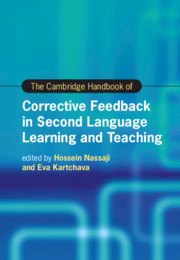Book contents
- The Cambridge Handbook of Corrective Feedback in Second Language Learning and Teaching
- Cambridge Handbooks in Language and Linguistics
- The Cambridge Handbook of Corrective Feedback in Second Language Learning and Teaching
- Copyright page
- Contents
- Figures
- Tables
- Contributors
- Acknowledgments
- Introduction Corrective Feedback in Second Language Teaching and Learning
- Part I Theoretical Perspectives on Corrective Feedback
- 1 Corrective Feedback from Behaviorist and Innatist Perspectives
- 2 Interactionist Approach to Corrective Feedback in Second Language Acquisition
- 3 Cognitive Theoretical Perspectives of Corrective Feedback
- 4 Corrective Feedback from a Sociocultural Perspective
- Part II Methodological Approaches in the Study of Corrective Feedback
- Part III Different Delivery Modes of Corrective Feedback
- Part IV Feedback Provider, Feedback Intensity, and Feedback Timing
- Part V Corrective Feedback and Language Skills
- Part VI Contexts of Corrective Feedback and Their Effects
- Part VII Learners’ and Teachers’ Feedback Perspectives, Perceptions, and Preferences
- Part VIII Individual Differences, Tasks, and Other Language- and Learner-Related Factors
- Index
- References
3 - Cognitive Theoretical Perspectives of Corrective Feedback
from Part I - Theoretical Perspectives on Corrective Feedback
Published online by Cambridge University Press: 26 February 2021
- The Cambridge Handbook of Corrective Feedback in Second Language Learning and Teaching
- Cambridge Handbooks in Language and Linguistics
- The Cambridge Handbook of Corrective Feedback in Second Language Learning and Teaching
- Copyright page
- Contents
- Figures
- Tables
- Contributors
- Acknowledgments
- Introduction Corrective Feedback in Second Language Teaching and Learning
- Part I Theoretical Perspectives on Corrective Feedback
- 1 Corrective Feedback from Behaviorist and Innatist Perspectives
- 2 Interactionist Approach to Corrective Feedback in Second Language Acquisition
- 3 Cognitive Theoretical Perspectives of Corrective Feedback
- 4 Corrective Feedback from a Sociocultural Perspective
- Part II Methodological Approaches in the Study of Corrective Feedback
- Part III Different Delivery Modes of Corrective Feedback
- Part IV Feedback Provider, Feedback Intensity, and Feedback Timing
- Part V Corrective Feedback and Language Skills
- Part VI Contexts of Corrective Feedback and Their Effects
- Part VII Learners’ and Teachers’ Feedback Perspectives, Perceptions, and Preferences
- Part VIII Individual Differences, Tasks, and Other Language- and Learner-Related Factors
- Index
- References
Summary
The role of corrective feedback (CF) in the L2 learning process has for decades remained a dominant issue in the (I)SLA strands of research, albeit some overlapping between these two contexts. Indeed, there are several cognitive theoretical underpinnings cited by empirical CF studies to account for the role or lack thereof of CF in the L2 learning process, for example, the Monitor Model (Krashen, 1982), the Interaction Hypothesis (Long, 1996), the Noticing Hypothesis (Schmidt, 1990), the Output Hypothesis (Swain, 2005), Skill Acquisition Theory (DeKeyser, 2015), and the Model of the L2 learning process in ISLA (Leow, 2015), be it oral, written, or computerized or digital. This chapter (1) traces the early roots of CF, (2) presents a coarse-grained theoretical feedback processing framework to discuss the cognitive theoretical underpinnings postulated to account for the role of CF in L2 development, (3) provides a list of cognitive processes assumed to play a role during CF appropriation, and (4) reports on each theoretical underpinning followed by a commentary on their ability to account for the role of CF in L2 development.
Keywords
Information
- Type
- Chapter
- Information
- The Cambridge Handbook of Corrective Feedback in Second Language Learning and Teaching , pp. 65 - 84Publisher: Cambridge University PressPrint publication year: 2021
References
Accessibility standard: Unknown
Why this information is here
This section outlines the accessibility features of this content - including support for screen readers, full keyboard navigation and high-contrast display options. This may not be relevant for you.Accessibility Information
- 4
- Cited by
